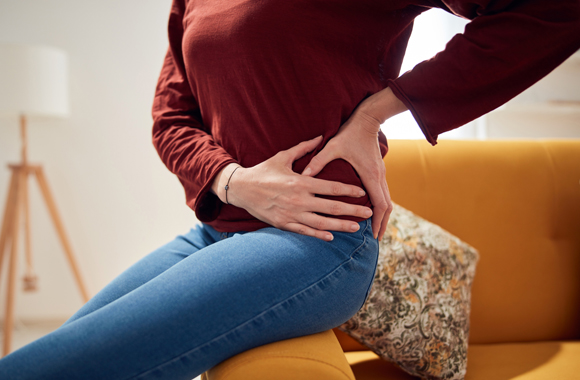Hip pain is a common complaint that can be caused by a wide variety of problems. Identifying the precise location of your hip pain can provide valuable clues about the underlying cause.
Problems within the hip joint itself tend to result in pain on the inside of your hip or your groin. Hip pain on the outside of your hip, upper thigh, or outer buttock is usually caused by problems with muscles, ligaments, tendons, and other soft tissues that surround your hip joint.
Our doctors can diagnose and treat a wide range of hip-related problems using conservative and surgical methods. Read more about the conditions and treatments for hip pain.

Common Hip Conditions
Since the hip is essential for mobility and upholds our body weight, it is highly vulnerable to several painful conditions that can affect a person’s quality of life.
Sacroiliac Joint Dysfunction
Sacroiliac (SI) joint dysfunction occurs when the SI joint becomes inflamed or misaligned. The SI joint connects the sacrum to the iliac bone of the pelvis and serves to help with shock absorption and forward and backward bending. When there is too much or too little movement in the joint, it can lead to SI joint dysfunction, which causes:
- Radiating pain down the legs
- Shooting pains in the lower back
- Limited mobility
- Loss of bladder or bowel control
Treatment for SI joint dysfunction at Motion Orthopaedics will often entail pain medications, manual manipulations, supportive braces, or anti-inflammatory injections.
Femoroacetabular Impingement
Femoroacetabular impingement (FAI), or hip impingement, is a condition where the ball of the joint pinches against the cup in the hip. When this occurs, the labrum can be damaged, which usually leads to stiffness and pain. There are three types of hip impingements:
- Cam impingement: occurs when the head of the femur is not round
- Pincer impingement: develops when the socket has extra bone that extends over the head of the femur
- Combined impingement: when both cam and pincer impingement are present
FAI typically forms during childhood, but it may also arise in athletes who compete in sports with frequent twisting or squatting. To soothe the discomfort associated with this condition, your orthopedic specialist at Motion Orthopaedics may suggest conservative treatment options or surgery to address the damaged tissues in the hip and the irregular shape of the bone structures.
Treatments for Hip Conditions
There are a variety of nonsurgical treatment options for the above hip conditions. Among the most effective non-invasive treatment techniques include:
- Physical therapy
- Rest
- Activity modification
- NSAIDs
- Injections: intra-articular, psoas, or trochanteric bursa injections
- Ice or heat therapy
- Over-the-counter pain relievers
When conservative methods are not successful at relieving hip pain, your orthopedic specialist may recommend surgical intervention.
Hip Arthroscopy
A hip arthroscopy is a minimally-invasive procedure that utilizes a specialized endoscope, or arthroscope, to examine the interior of the joint. The arthroscope is attached to a fiber-optic video camera that transmits to a high-definition monitor, which allows the orthopedic surgeon to view and repair the structures in the hip. With a hip arthroscopy, you will have shorter recovery times, less muscle and tissue damage, and a lower amount of pain postoperative. Some hip procedures that can be performed arthroscopically include:
- Synovectomy
- Labral debridement
- Labral refixation
- Partial psoas release
- Acetabuloplasty
- Osteochondroplasty
- Arthrotomy
Total Hip Replacement
In a total hip replacement, the diseased portions of the joint are replaced with artificial parts, which are usually made of metal, ceramic, or durable plastic. A hip replacement is necessary when the hip has been damaged from a severe fracture or a type of arthritis to the extent where your pain interferes with day-to-day life. Following this procedure, you will undergo physical therapy to gradually revive your mobility and flexibility.




